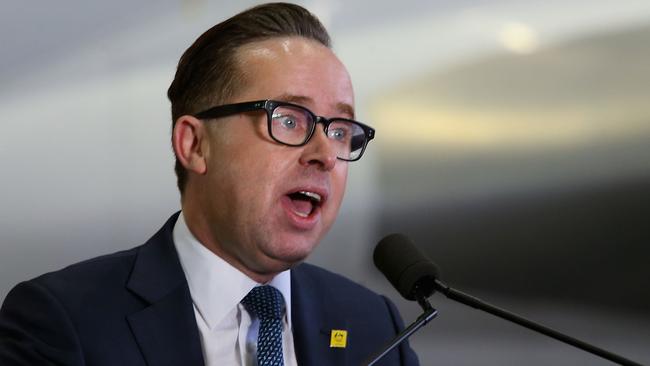Qantas soars to new destinations
The airline’s return to dividends highlights the success of its transformation and its exciting new opportunities ahead.

On Qantas’ (QAN) preferred measure of underlying profit before tax the group’s earnings were up 57 per cent to $1.53 billion. For those cynical about the use of underlying profit numbers, its statutory after-tax earnings were up 84 per cent to $1.03 billion.
No matter how one measures it, the hockey-stick like recovery since Qantas’ record $2.8 billion loss in 2014 is a remarkable achievement. It has been helped by the plunge in oil prices and jet fuel costs, which boosted underlying pre-tax earnings by $664 million, but it wouldn’t have been attainable if not for the continuing benefit of the ambitious transformation program Joyce launched in 2014.
That program generated $557 million of benefits in the last financial year, taking the overall cost and revenue gains since 2014 to $1.66 billion. In its final year – 2016-17 – it is expected to add a further $450 million.
Moreover, the dramatic improvement in performance isn’t driven by Qantas’ domestic dominance, although that has helped, but is across-the-board.
Qantas International, which lost $500 million in 2014, recorded underlying earnings before interest and tax of $512 million in the latest financial year. The Jetstar group nearly doubled its underlying EBIT, to $452 million, with Jetstar Japan not only profitable for the first time but announcing a significant expansion. Qantas Loyalty increased its EBIT 10 per cent to $346 million. Only Qantas Freight experienced lower earnings, down 44 per cent to $64 million.
The core of Qantas was its domestic operations, with Qantas and Jetstar’s domestic businesses combing to generate $820 million of underlying earnings and, with a capacity share of 62 per cent, hoovered up 83 per cent of the domestic industry’s profit pool.
Despite its expensive makeover, its rival, Virgin Australia, could manage an underlying pre-tax profit of only $41 million in the same period. Qantas has been maintaining and even increasing its margin advantage over Virgin while reducing the unit cost advantage Virgin once held.
The strong operational performance – which saw Qantas cope with a reduction in unit revenue by cutting unit costs, even if the impact of lower fuel costs were excluded – generated $2.8 billion of operating cash flow and $1.7 billion of free cash. It also produced a 23 per cent return on capital.
That has enabled the group to reward its shareholders and employees. Having already returned about $1 billion to shareholders over the course of the financial year through a capital return and share buy-back, Qantas announced another $366 million buy-back and a seven cents a share fully-franked dividend that will absorb $134 million.
It will also reward 25,000 non-executive employees who had been subjected to an 18-month pay freeze with $3000 bonuses, totalling $75 million. Qantas will have distributed $160 million of cash bonus payments to staff as a result of its last two years’ results.
Given the historic friction between Qantas and its employees, that’s an intelligent way of building on relationships that appear to have improved dramatically since the grounding of the fleet in 2011.
The result was achieved despite the best efforts of Virgin, with its vastly upgraded and broadened offer in the domestic market, the softness in domestic demand in the June quarter and increasing competitiveness internationally, where carriers have been flowing their gains on fuel costs through to their prices.
That underscores how much more nimble Qantas has become, shelving planned domestic capacity growth as demand softened and shifting capacity off the trans-Pacific to Asian routes as the economics of its international routes changed.
With its exposure to higher oil prices near fully-hedged, Qantas has probably ensured that its fuel bill in 2016-17 will, at around $3.1 billion to $3.2 billion, be no higher, and potentially slightly lower, than it was in 2015-16. Its sophisticated hedging has been a significant differentiator in its performance relative to its competitors, given the materiality of fuel prices to airline earnings.
While it isn’t providing any profit guidance for the current financial year, it is adopting a reasonably cautious stance. In the first half capacity growth is expected to be around 2 per cent to 3 per cent and weighted to the international business. Domestic capacity is expected to be flat or slightly reduced, while international capacity is expected to increase about 4 per cent.
Unit revenue is expected to be below that of the same half last financial year but Qantas says it expects that to be offset by lower fuel costs and the remaining unit cost improvements to flow from the final year of the transformation program.
Alan Joyce was asked today, as he always is, about the possibility of his retirement (it used to be about the potential for his sacking). As usual, he has no current plans to relinquish the helm. Why would he?
After a torrid few years, with the end of possibly the biggest transformation program in Qantas’ history in sight and on track, to be followed by the arrival of a wave of Boeing 787 Dreamliners that will significantly improve both the product and economics of its international business and some exciting opportunities opening up for Qantas and Jetstar in Asia, he and the group are finally in a pretty good place.
Mind you, this is the airline industry, which has a range of vulnerabilities and a history of destructive behaviour. Neither Joyce nor Qantas – nor Qantas shareholders -- will be complacent about its ability to maintain its current stellar performance.






The resumption of dividends after a seven-and-a-half-year hiatus is not just a testament to the size of Qantas’ record profit but its quality and the board’s view of its sustainability. It also underscores the scale and quality of the transformation Alan Joyce has overseen since the dark days of 2011.